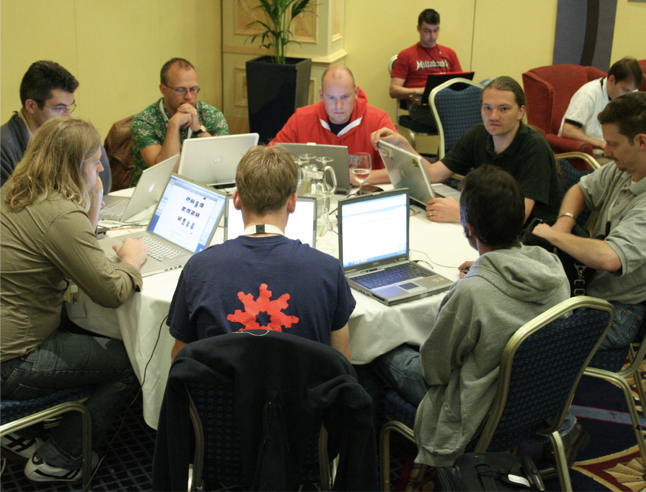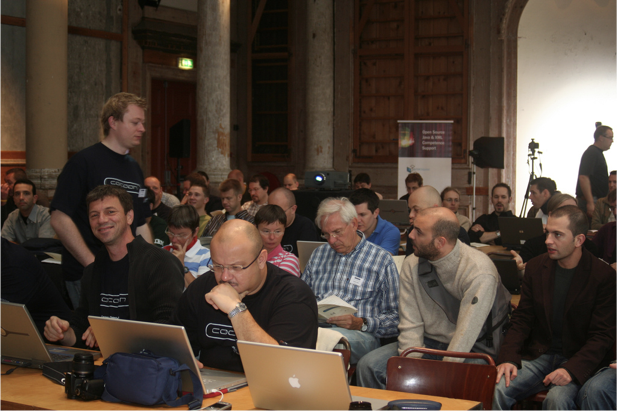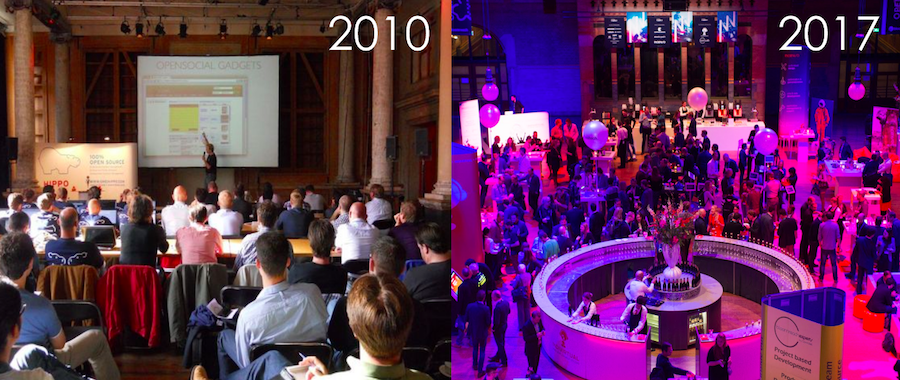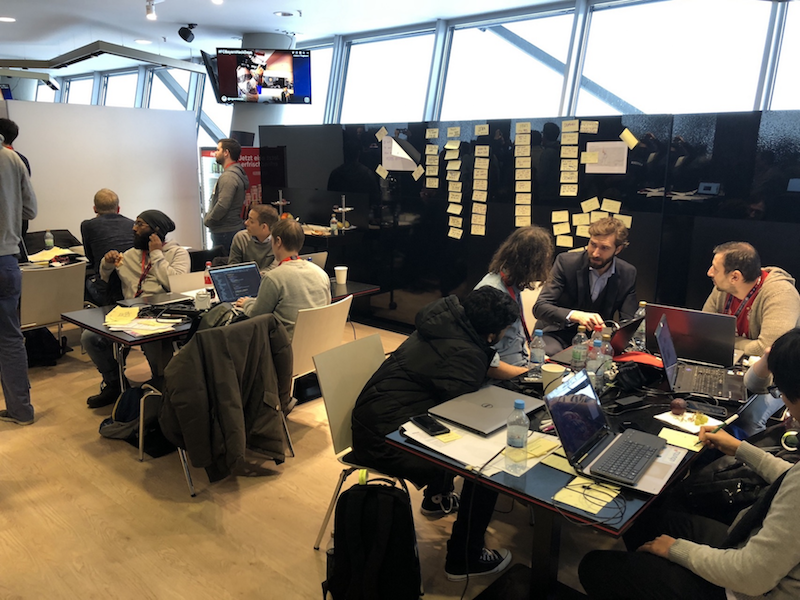The Rise of the Enterprise Hackathon
Arjé Cahn
2018-03-26
Recently, Bloomreach got the chance to help with the first hackathon held by FC Bayern Munich, the German football club. There were plenty of questions my team asked; what the focus was, who was participating, and what APIs Bloomreach needed to provide to give safe access to FC Bayern content. What hit me later is that no one asked why a football team would need a hackathon in the first place.
It was never a question because everyone at Bloomreach is familiar with FC Bayern’s track record of quickly rolling out digital initiatives to their global fan base. Using a hackathon for rapid-fire innovation seemed absolutely in character.
This trend, of not-traditionally-software businesses embracing hackathons, is one that I’m excited to see. These events have always been a boon of creativity, a powerful community builder, and a lot of fun. Businesses with any form of digital experience should consider tapping into the benefits of collaborative development and the enterprise hackathon.
Hackathons have always been more than hardcore coding
My first hackathon was back in 2001. I was invited to join an Apache hackathon and, to be completely honest, I was worried that my coding skills wouldn’t be up to scratch. But what made Apache hackathons so appealing was the strong emphasis, then and today, on Community Over Code. The solutions require talented, advanced coders, yes, but bringing in diverse insights is what makes the most applicable solutions.
You contributed in whatever way you could, and in return you got to be a part of the whirlwind of collective development. I quickly became a regular, jumping at every chance to team up with people around the world to solve problems - it was addictive. We quickly started hosting Apache meetups and get-togethers ourselves (pictured below) and the enthusiasm our team had for focused, collaborative development made it a typical way to work in the office. Additionaly, the Apache emphasis on community was the cornerstone of our (still present) commitment to Open Source.


The Enterprise hackathons I’ve seen are kicking the sense of a diverse community up another notch - including marketers, product managers, daily users, and brand enthusiasts into the mix. Which makes sense, because a viable enterprise initiative is more than just the code, it’s the how in-depth the problem is understood, the user experience, and the story that ties the solution into the rest of the brand. The fan experience pitches at the FC Bayern hackathon all had to include a plan for user adoption, and the recent Capital One Hackathon told participants up front to focus on ease of use, customer rewards and family education. It’s clear that these companies are using these events to get well rounded, applicable solutions - at an incredible speed.
A Boon for Enterprise Experience
Hackathons are exciting, yes, but they also take a lot of resources. So what is the return on investment?
Community
The original heart of the hackathon. They are a chance for your community to meet in person, contribute, and get excited about what you’re doing. Internally, it helps teams get to know who to go to, across departments, for different skills and specialities. Externally, you cultivate a community of brand fans, such as Capital One does through their developer hub. I can vouch for this tactic, we started building our own community through a hackathon and have watched it grow from there.

Remove the starting line fear
You have a problem, you have a finite amount of time, you pull together and get it done. It’s an incredible foundation for teams in general. You learn to start with the minimum viable product and iterate quickly, without letting all the “what ifs” stop you from getting started. As Paul Buchheit, the creator of Gmail puts it, “The first thing I do on day one is build something useful, then just keep improving it.”
Viable solutions
When you provide a well defined problem, gather a well rounded team, provide the right tools, and dedicate time to narrowing in on one specific problem - incredibly useful things pop out. Many Facebook features were born from internal hackathons and a plethora of startups had the first burst of inspiration at hackathons. They are also a great kick-start to more cross-department work day-to-day. As teams experience the speed that comes from a focused, collaborative approach and learn the (often surprising) skill sets of their peers, the hackathon mentality finds its way into business as usual.
A better experience
The focus on digital experience is the reason that Enterprise hackathons are on the rise. You no longer need to be primarily a tech company to get major benefits out of digital - every industry is now differentiating with experience. To stay competitive, you need to get creative - and hackathons are a great way to do so. You can tap the minds of your external community and day-to-day users for a fresh spin that’s removed from internal politics and resourcing knowledge. Just as importantly, if not more so, you give internal teams a chance to play outside the lines.
Go Forth and Hack
The rewards are there to be reaped, but how do you ensure you get the most out of these events?
Define the real world problem
It’s tempting to just pick a hot topic (VR, fan apps, bitcoin) and ask people to build you something cool but successful hackathons present a practical, current challenge. FC Bayern had each sponsor define a clear niche, from the journey to the stadium to how to include remote fans during gameplay, and Conrad Electronic’s recent event focused on their B2B eCommerce solution. Starting with a clearly defined, actual paint point is the key to receiving viable solutions.
Commit to a follow up
Rome wasn’t built in a day and your fully marketable experience isn’t built in 24 hours. If you put in the resources to make the event happen, it makes sense to dedicated resources post-event to work with the winning idea to make it ready for market. You commit to implementing creative experiences, and proof of follow through encourages more participation in the future - a win win.
Provide a structured process
Cross-department teams are going to have a wide spectrum of experience working in quick sprints, and it can be easy to get bogged down in a single step. Providing a structured process and dedicating specific time periods to design, prototyping, and testing solutions helps keep teams on track. In my experience, Google Venture’s Design Sprint is a very successful template.
A space to create
Providing your hackers with a library of the latest VR/AR/IoT toys is great if you have the resources, but simply ensuring there is plenty of food, tables, whiteboards, post its, pens, power outlets, and fast wifi makes for a great space for collaborative development. As seen below, the FC Bayern Munich hackathon provided plenty of space for teams to brainstorm and work.

APIs
I saved the most important for last. APIs can make or break a hackathon. APIs let teams plug and play, opening up access to data and services quickly and securely. If you want these solutions to be a part of a connected digital experience (which we all do), you have to provide the tools to connect. Building new experience initiatives through APIs is also the way to pull that hackathon spirit into everyday business because...
The Key to Rapid Innovation is Openness.
To come up with creative solutions, people need the freedom and tools to tackle problems from a new angle. This is true for hackathons and for innovation in general. Building a differentiating experience requires you to build on a fundamentally open platform that is designed for quick development - not a closed system that corners you into one way of doing things. Open architecture is driving the connected experience across industries, from commerce to B2B to financial services because APIs simply make it less work (and less risk) to try new solutions.
Hackathons have always been the place to throw hesitation to the wind and dive right into building. Enterprises are clearly seeing the benefit of this experimentation, both through these events and by giving internal teams the ability to pop tools and touchpoints in and out of the experience as they see fit. To get in on the action, you have to be ready for innovation to happen - put the infrastructure in place, bring together the right people, encourage them - and it will come.
Photo credit: Bloomreach Connect 2017; Annelore Photography. Bayern Munich Hackathon; Niels Koekoek.

